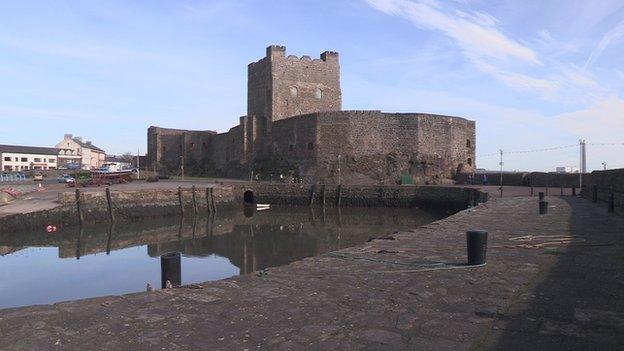Carrickfergus Castle: History unearthed as dig is extended
- Published

Carrickfergus Castle, in County Antrim, dates back to Anglo-Norman times and was in constant military use for almost 800 years
New information about the history of a 12th Century castle is being revealed by an archaeological dig.
Carrickfergus Castle, in County Antrim, is the best preserved Anglo-Norman castle on the island of Ireland.
Experts from Queen's University Belfast and the Northern Ireland Environment Agency have been excavating trenches at the site since early last month.
So much has been discovered that the dig has been extended by three weeks until the end of March.
So far, the archaeologists have found pottery fragments, uniform buttons and coins at the castle, which was strategically sited overlooking Belfast Lough.
Full of surprises
They have said they were surprised to discover parts of a 19th Century tunnel extending into the area where the medieval Great Hall once stood.
They have also discovered the foundations of never seen before medieval walls which show the outline of the Great Hall.

Vsitors to Carrickfergus Castle are able to view the excavations as they take place
QUB assistant excavation director, Ruairí Ó Baoill, said the work has been full of surprises.
"We can see the whole 750 years of garrison life here in the castle, from medieval wall foundations to a late Victorian munitions rail that was used to bring munitions in from the pier beside the castle right into the inner ward."
The first parts of Carrickfergus Castle were built on the instruction of John De Courcy, soon after his 1177 invasion of Ulster.
From that time the castle was in constant military use until 1928.
Dr John O'Keefe, who is also involved in the dig, said that when the work is complete they will know much more about the history of the castle and the project will inform future developments at the site.
"We have found out more about the layout of the buildings, we have found out more about the age of some of the buildings, we have found out more about the history of them," he said.
'Fascinating'
Dr John O'Keefe added the information gathered in the dig "will also mean in future we won't harm any of the remains that are here".
Northern Ireland's Environment Minister Mark H Durkan said the archaeological work would help improve the visitor offer at the castle.
"I think it is fascinating that the artefacts that have been dug up are from so many different periods and indeed so many different places.
"We have unearthed some pottery from as far afield as France," Mr Durkan said.
"I think it is vitally important that we learn more about our past, about the history of this castle and that will in turn make it a more interesting place for people to visit now in the present and in the future."
The castle remains open to the public while the work continues.
The minister said entrance to the site would be free for one week, beginning on 22 March, so as many as possible can watch the dig in progress.